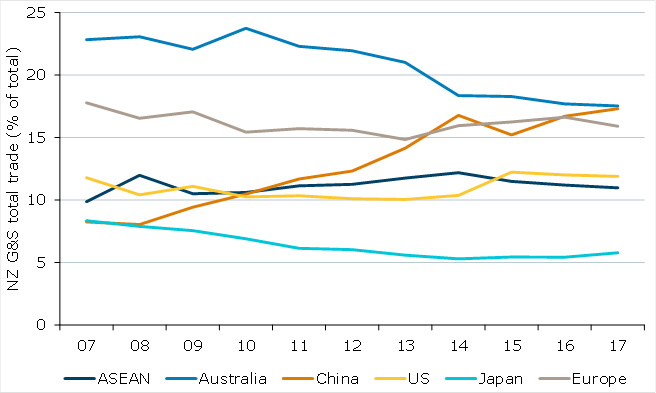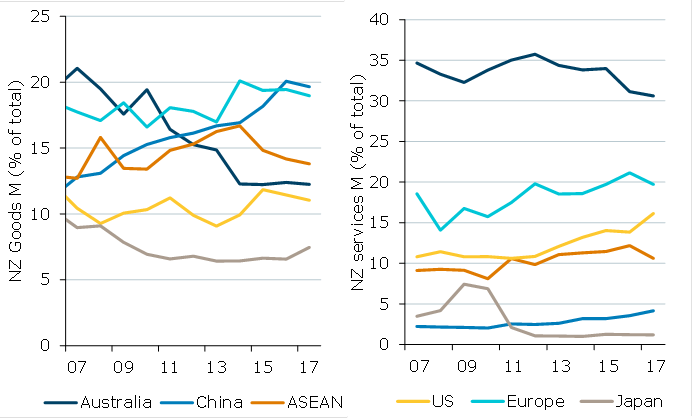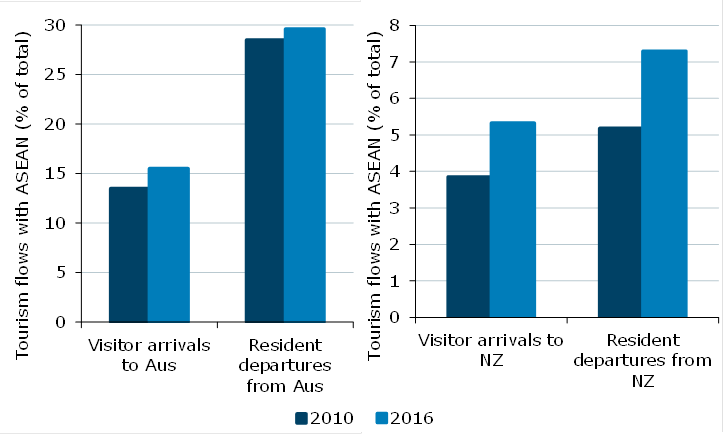-
The ASEAN’s emergence as an important trade ally of New Zealand is well known. However, trade between the two regions as a share of NZ’s total trade has remained fairly stagnant over the last decade.
While Australia and China dominate New Zealand’s trade volumes, at ANZ we see scope for NZ-ASEAN trade to grow in the coming years.
There are several potential areas where bilateral trade can be enhanced, with the maximum scope lying in the services category.
Existing trade arrangements like the Australia-NZ-ASEAN free trade arrangement (AANZFTA), the NZ aid programme aimed to enhance food security in ASEAN and negotiations within the Regional Comprehensive Economic Partnership (RCEP) will likely boost ties further.
"Little diversification over the years is one of the primary reasons for the static trade share in the last decade.”
ASEAN’s growing importance in NZ’s overall trade
{CF_IMAGE}
Closer analysis
ASEAN as a group is NZ’s fifth-biggest trading partner, after Australia, China, Europe, and the US. Eleven per cent of NZ’s trade is with ASEAN, which has grown by close to $US3.4billion in the last seven years.
However, a closer analysis reveals NZ’s share of trade with ASEAN has remained stagnant in the 10 per cent to 12 per cent range since 2007.
NZ’s total trade with major partners
{CF_IMAGE}
Over the last decade, ASEAN’s share of NZ goods imports has fallen sharply while its share in NZ services imports has risen somewhat.
NZ runs an overall trade deficit with ASEAN. It enjoys a trade surplus only with the Philippines and Myanmar. Within ASEAN Singapore is NZ’s biggest trading partner.
Little diversification over the years is one of the primary reasons for the static trade share in the last decade.
ASEAN’s goods imports to NZ have been falling in the last five years
{CF_IMAGE}
Scope for services
NZ’s biggest services exports to ASEAN include personal travel, education-related travel, and other business services.
NZ and Australia tourism flows with ASEAN in 2016
{CF_IMAGE}
In the second quarter of 2017, travel (including business and personal travel) made up 75.6 per cent of total services exports to ASEAN. This is not surprising given rising tourist numbers between ASEAN and NZ.
However we do see potential for this to grow further, as these numbers are low compared to tourism flows between Australia and ASEAN.
Australia is NZ’s biggest tourism destination both in terms of arrivals and departures (close to 40 per cent). Geographical proximity, close historical and cultural ties and the higher number of direct flights facilitates this relationship.
In 2017, a total of seven Australian destinations had direct flights to and from NZ, compared to only five in the 10 countries which make up ASEAN. Tourism flows could improve if the number of direct flights between ASEAN and NZ increase.
While NZ exports of travel for education to ASEAN are close to 9.6 per cent of its total education-related exports, it is much lower than other markets like China (23.4 per cent of the total).
The fact 38 per cent of NZ’s total travel exports are education-related shows the sector is a good prospect NZ can tap into.
Food for thought
Even though food forms the bulk of NZ’s total merchandise exports to ASEAN, there is room to enhance exports of certain food products, especially within untapped sectors.
The biggest gains though, can be made in the services category, given its vast growth prospects across both regions. Although small, engineering and other scientific services can be a good future growth avenue for NZ services exports to ASEAN.
Services exports from ASEAN to NZ are also expected to grow as new destinations emerge on the tourist map. The growth of new financial hubs in cities such as Manila can also help dilute the increased concentration of financial activities based out of existing hubs like Singapore and Kuala Lumpur.
While, goods trade have some potential to grow in certain sectors and investment can be enhanced, we expect services trade to hold the biggest potential for both regions. There are already existing trade arrangements in the form of AANZFTA.
China’s RCEP, if successfully concluded, will help to improve trade terms between ASEAN and NZ further. This will likely go beyond goods and services trade to cover investments as well.
These FTAs aim to promote foreign investment in the region through the strengthening of institutions and regulations. By 2020, 99 per cent of existing NZ trade in goods with Indonesia, Malaysia, the Philippines, and Vietnam, is expected to be duty free.
Such initiatives will likely pave the way for further economic cooperation between ASEAN and NZ.
Khoon Goh is the Head of Asia Research at ANZ
The views and opinions expressed in this communication are those of the author and may not necessarily state or reflect those of ANZ.
-
-
-
-
anzcomau:Bluenotes/asia-pacific-region,anzcomau:Bluenotes/global-economy
Scope for growth in NZ, ASEAN trade
2017-10-13
/content/dam/anzcomau/bluenotes/images/articles/2017/October/GohNZAsean_IMG1.png
EDITOR'S PICKS
-
China’s upcoming NCCPC is expected to see President Xi outline a new ideology for the country’s future.
11 October 2017 -
What will come of China’s attempt to strike a balance in its economy?
4 October 2017




